
Bremen Airport is the international airport of the city and state of Bremen in Northern Germany. It is located 3.5 km (2.2 mi) south of the city and handled 1,81 Mio. passengers in 2023. It mainly features flights to European metropolitan and leisure destinations.

Karlsruhe/Baden-Baden Airport is the international airport of Karlsruhe, the third-largest city in the German state of Baden-Württemberg, and also serves the spa town of Baden-Baden. It is the state's second-largest airport after Stuttgart Airport, and the 13th-largest in Germany with 1,731,055 passengers as of 2023 and mostly serves low-cost and leisure flights.
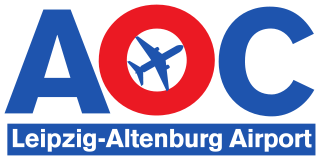
Leipzig–Altenburg Airport is a German regional airport in Nobitz, 6 km (3.7 mi) southeast of Altenburg and 42 km (26 mi) south of Leipzig, in the state of Thuringia. It was the second largest airport in Thuringia after Erfurt-Weimar Airport when it had scheduled traffic. In 2007, it served almost 140,000 passengers. All scheduled services ceased in 2011.

Mönchengladbach Airport is a small regional airport located 4.4 km (2.7 mi) northeast of Mönchengladbach and 15.2 km (9.4 mi) west of Düsseldorf. It is co-owned by the company which also runs Düsseldorf Airport (70%) and the local utility company NVV AG (30%).
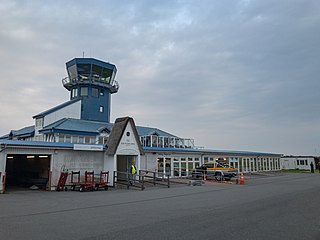
Sylt Airport is the airport on the German island of Sylt located in the municipality of the same name. It mostly features summer seasonal scheduled traffic to major German cities as well as general aviation and gliding. Sometimes the airport is referred to as Westerland/Sylt named after Westerland, a well-known part of the municipality of Sylt which however is not the nearest settlement to the airport.

Kiel Airport is a small regional airport in Kiel, Germany. It is located in the borough of Holtenau, 8.3 km (5.2 mi) north of the city centre. It is registered as a public airfield. As of 2006, it served 30,528 passengers p. a.
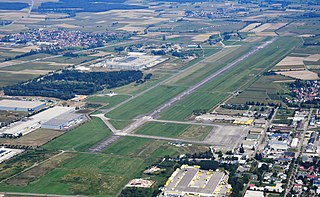
Lahr Airport is a privately owned and operated commercial airport located in Lahr, Germany, situated in the Black Forest. It is used for general aviation and freight transport.

Mannheim City Airport is a minor regional airport serving the German city of Mannheim. It is mainly used for general aviation.
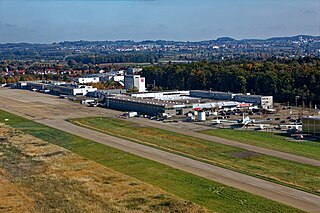
Friedrichshafen Airport is a minor international airport 1.9 miles (3 km) north of Friedrichshafen, Germany, on the banks of Lake Constance. It is the third biggest airport in the German state of Baden-Württemberg after Stuttgart and Karlsruhe/Baden-Baden and served 559,985 passengers in 2015. Friedrichshafen features flights to European metropolitan and leisure destinations. Due to its proximity to the Austrian Alps it is also heavily used during the winter by skiing tourists.

Saarbrücken Airport, or Flughafen Saarbrücken or Ensheim Airport in German, is a minor international airport in Saarbrücken, the capital of the German state of Saarland. It features flights to major cities throughout Germany as well as some leisure routes.

The approximately 5,400 railway stations in Germany that are owned and operated by the Deutsche Bahn subsidiary DB Station&Service are divided into seven categories, denoting the service level available at the station.

Braunschweig Wolfsburg Airport is an airport in Braunschweig, Germany. Originally constructed by the German Air Ministry in the 1930s, it is located on the northern edge of Braunschweig, which is situated between Hanover and Magdeburg. Braunschweig Airport traditionally has been a major centre of gliding in Germany and is also used for general aviation, especially business traffic.

Siegerland Airport or Siegerlandflughafen in German is a small regional airport in Burbach in the Siegerland region near Siegen, Germany. It was formerly served by the Scheuerfeld–Emmerzhausen railway and is presently used as the maintenance base for Avanti Air.

The Federal Ministry for Digital and Transport, abbreviated BMDV, is a cabinet-level ministry of the Federal Republic of Germany. Its main office is located in Berlin, while the majority of its civil servants and employees work in Bonn, the secondary seat.
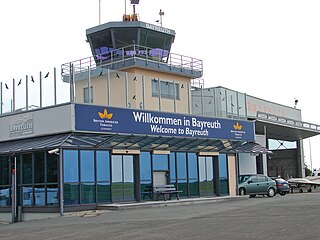
Bayreuth Airport, also called Verkehrslandeplatz Bayreuth in German, is a general-aviation non-towered airport serving the city of Bayreuth, Germany. It was formerly known as Bindlacher Berg Airport.

Augsburg Airport is a regional airport in Affing, 7 km (4.3 mi) northeast of the city of Augsburg, the third largest city in the German state of Bavaria. It is used for business and general aviation with very little passenger airline traffic.
The Single European Sky ATM Research 3 Joint Undertaking is an institutionalised European public-private partnership, established in 2021, to accelerate through research and development the delivery of the Digital European Sky, as part of the SESAR project. Initiated in 2004, the SESAR project is the technological arm of the EU's Single European Sky initiative to integrate EU Member States' ATM systems. Bringing together the EU, Eurocontrol, and more than 50 organisations covering the entire aviation value chain, including drones, this European partnership is investing more than EUR 1.6 billion between now and 2030 to accelerate, through research and innovation, the delivery of an inclusive, resilient and sustainable Digital European Sky.
Remote and virtual tower (RVT) is a modern concept where the air traffic service (ATS) at an airport is performed somewhere other than in the local control tower. Although it was initially developed for airports with low traffic levels, in 2021 it was implemented at a major international airport, London City Airport.
Frequentis is an Austrian high-tech company that develops communication and information systems in fields such as air traffic management and public safety & transport.

JadeWeser Airport is a minor unscheduled airport near Wilhelmshaven, Lower Saxony, Germany. It is located near JadeWeserPort, a major German deep-sea harbour construction site.

















